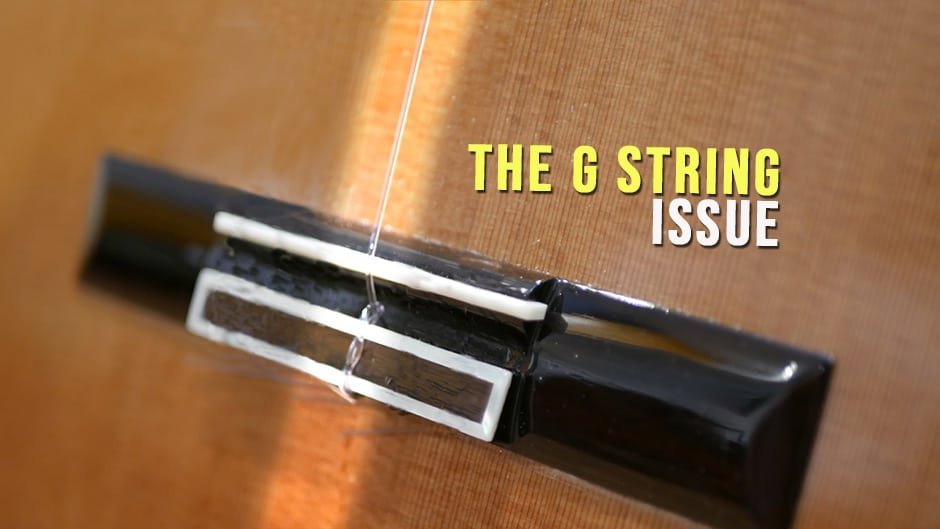Years ago, when I got my first classical guitar after years of playing the acoustic and electric versions, I quickly noticed that the third string sounded funny. It was a beautiful sounding guitar to my ears overall, but that third string did sound… off. It was a dull and unflattering tone. I may have blamed it on my cheap beginner’s guitar, but I find the problem of a bad sounding G string persists to this day.
Why does the G string of a classical guitar sound dull? While more responsive classical guitars may curtail the tubby sound a little, the problem is caused by the string itself. The G string is the thickest monofilament string on the classical guitar with its greater mass, making it relatively stiff and inflexible, which in turn inhibits higher harmonics, giving the string a dull or flat sound.
A feature of this sound or tone – often described as ‘dull’, ‘flat’ and ‘tubby’ among many others – is not just the absence of higher harmonics but also less sustain. A sound with less of the rich overtones that don’t last long probably deserves all that name-calling!
So, it is the thickness of the string that causes the bad sound. Are some brands of strings better than others? What if we tried something other than a nylon third string? Would that help? This is worth getting into and solving once and for all.
Before we dive deep, there is a difference between a G string sounding tubby and a G string buzzing. If buzzing is your issue, check my article What To Do About G String Buzzing for helpful tips.
Let’s get the problem straight

The G-string is notorious for having a dumpy sound. Or a plasticky sound. Or a… you get the drift. For a moment what if we took a pause and asked, is this really true?
There is a body of opinion – a minority to be sure – which says there is no real issue with the third string and the way it sounds! Folks who have always played the classical guitar as their instrument of choice, as against crossing over from the steel-strung guitar, think there’s nothing ‘wrong’ with the sound of the G string. Sure, it is different, but then it is a different instrument.
Taking this line of thought further, they believe that it is the crossover folks, with their background of resonant strings, who are overreacting to the sound of the nylon cousin.
All this is by way of saying, trust your own ears. If you think there is a problem with the sound, there is indeed a problem. If you can’t hear the problem, there isn’t any and you don’t want to solve it. Go make some music instead.
So what can we do about that string?
Most classical guitar teachers insist that students experiment with different brands and tensions of strings. There are quite a few excellent choices in classical guitar strings out there and at least a few will work perfectly for your guitar (and for your ears.) I have a related article on the 5-Step Guide to Choosing Your Perfect Strings on the site which suggests interesting variants to try out from top brands in a systematic manner.
As you experiment with the aim of a better G string in mind, you will find that certain string choices are more prone to a bad sound than others. The funky sounding ones will almost always be nylon variants. Materials other than nylon give you a better sound invariably.
Although I know of folks who use something like Hannabach’s Goldin strings, a regular nylon set, or Savarez CR510, again a regular nylon set, and are extremely happy with them. Without venturing into the world of carbon strings.
Try a carbon third string
If fewer overtones and less sustain is the basic issue, a fluorocarbon third string will solve it for many. Not a whole set of carbon strings, mind you, just the third string in carbon.
A carbon string works surprisingly well because carbon strings are thinner. Hence they always sound brighter.
There are many choices possible. Try the medium tension Carbonio variant from Galli Strings, for instance, or the high tension Savarez Alliance at Amazon. The Oasis carbon G is a great choice as well. Other big brands like Augustine, D’Addario and Hannabach also have excellent carbon options.
It is impossible to give definite recommendations because strings interact differently with different guitars. What works perfectly on my guitar may not work for you at all.
A friend of mine has 3 classical guitars fitted with 3 different brands of carbon thirds on each. Because every guitar is different, you have to experiment to find what works for your guitar.
On one of my own guitars, I use the Savarez New Cristal-cum-Corum strings (New Crystal is their regular nylon trebles and Corum is a variant of the basses) but I discard the third string and replace it with the Savarez Alliance third string (Alliance is their carbon treble strings). I get more sustain and the sound overall blends in. Again, for that specific guitar, this combination works beautifully.
A popular online source to purchase single strings is stringsbymail.com. I have no hesitation in recommending it to anyone. Overall, if a particular carbon G string works well for you, that’s all there is to it. The solution can be as simple as that.
For more information on carbon strings and what they can contribute to your sound, read my piece Trying Out Carbon Strings On Your Guitar.
Use a wound third string
It is reasonable to think, as some do, that the tubby sound of the G string is due to its being an unwound, bare nylon string (besides being the thickest of the lot.) Which is why a few players prefer a wound G string as against the regular nylon monofilament version.
The wound third string is made just like the bass strings on a classical guitar – metal wire wound around a multi-filament core. The transition from the basses through to the trebles is said to be smooth and pleasing. (I haven’t tried this option myself but it appears to work like a miracle for some.)
There are a few brands that offer a wound third string: Savarez has a Silver wound third, for instance. Savarez 520F is the full set with the wound third string (Amazon link).
Hannabach, for another, has three interesting variants of the wound third – in chrome, aluminum and silver.
These are very workable alternatives to settle the unruly third string, although a wound string is said to have a shorter life span. The aluminum variant is touted by some users as being an excellent option: great sound and a greater life.
________________
So, in the end, the problem of the bad sounding G string can be licked. It’s mainly about finding the right string for your guitar.
Some have even suggested on a popular online forum that a branded fluorocarbon fishing line makes for an excellent G string!
The same erudite forum has also thrown up the idea of going past the G string and getting yourself a new saddle instead. Specifically, a saddle made of pyrolytic carbon/mesquite substrate. This is said to remove tubbiness in the G string.
Whatever floats your boat.
_______________
On a related issue, I have an article on Why do Classical Guitar Strings Keep Going Out of Tune on the site. It gives you handy tips on what can become a vexing issue. Also, check if you have intonation issues on your guitar by referring to this article on intonation.
You may also find it instructive to read my article Why Do Bass Strings Squeak? when you move up and down the fretboard and what you can do to solve it once and for all.
Happy stringing!

A Wound 3rd String for Classical Guitar really should become more popular these days because it acts as a transitional string. Interestingly enough I tie Guitar string ball ends onto the ends of the strings to help them seat better so that the strings can travel over the saddle at a sharper angle.
Yes, I’ve heard of such ball ends being used but never tried them myself. Very interesting. Whatever works, I guess 🙂
Nice write up! Savarez 510 MJ/MR/MRJ Creation Series strings have a carbon G string in the set.